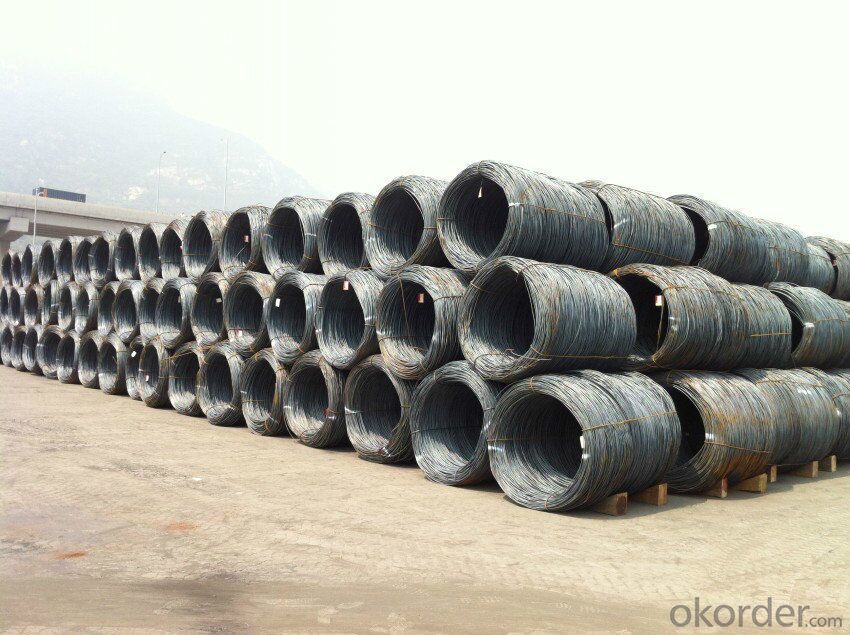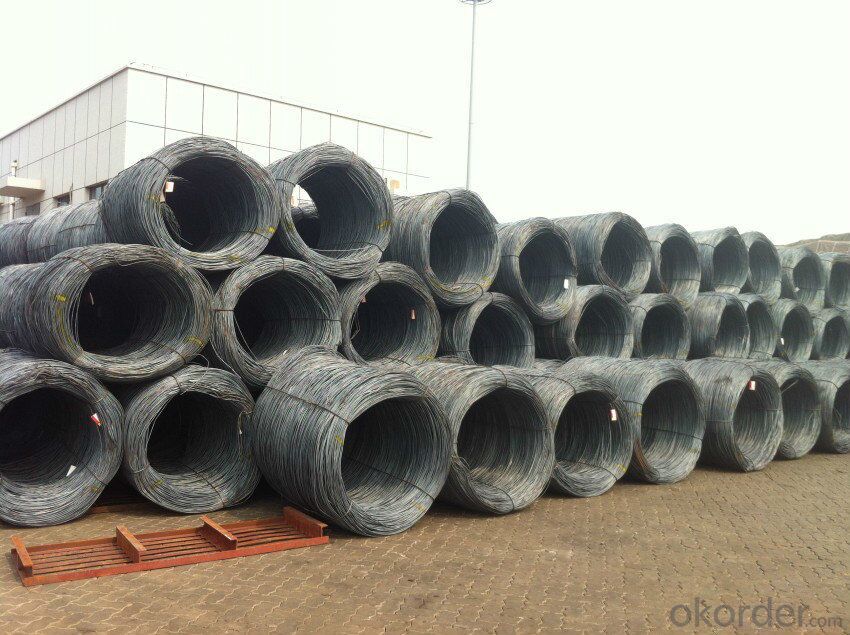Supply 6.5mm steel wire rod in coils in sale
- Loading Port:
- Tianjin
- Payment Terms:
- TT OR LC
- Min Order Qty:
- 25 m.t.
- Supply Capability:
- 500000 m.t./month
OKorder Service Pledge
OKorder Financial Service
You Might Also Like
Item specifice
Steel Grade: Q195/235, SAE1006-1018B Standard: ASTM, GB
Diameter: 5.5mm, 6.5mm, 7mm,8mm,9mm,10mm,12mm,14mm
Type: Drawn Wire Alloy or Not: Alloy Brand Name: HSKY
Technique: Hot Rolled Place of Origin: China Mainland
Chemical Composition:(Please kindly find our chemistry of our material based on SAE1006B and SAE1008B as below for your information)
High carbon/Low carbon/common carbon Steel wire rod | With boron for rebate tax |
Grade | SAE1006B SAE1008B SAE1018B |
Package | In coil ,in bundle, |
Coil weight | about 2000kg-3000kgs |
Size: | 5.5mm 6.5mm 8mm 10mm 12mm 14mm 16mm |
Types | High Carbon ,Low carbon ,Common carbon |
Exported Country | South Korea,Vietnam,Indonesia,Myanmar,Philippines and Afrca,Ect |
Delivery term: | within 30 days after receive the LC |
Payment Term: | LC at sight ,LC 30-120 days after B/L date, TT payment |
The Standard of Physical Properties:
Grade | Chemical Composition(%) | |||||
C | Mn | Si | S | P | Cr | |
SAE1006 | 0.03~O.07 | ≤0.32 | ≤0.30 | ≤0.045 | ≤0.040 | >0.30 |
Mechanical properties | ||||||
Yield strength(N/mm2) | Tensile strength(N/mm2) | Elongation(%) | ||||
250-280 | 350-380 | ≥32 | ||||
Grade | Chemical Composition(%) | |||||
C | Mn | Si | S | P | Cr | |
SAE1008 | 0.10max | 0.3~O.50 | 0.15max | 0.050max | 0.040 max | 0.30 min |
Mechanical properties | ||||||
Yield strength(N/mm2) | Tensile strength(N/mm2) | Elongation(%) | ||||
≥195 | 315-430 | ≥30 | ||||
Usage and Applications of Steel Wire Rod in Coil:
After hot-rolled the products shaped into coil and delivery as finished product, including round, square, rectangular, hexagonal and so on, Since most of the products are round, it is generally called wire rod. Steel wire rod is widely used in construction and manufacturing. Steel wire rod is mainly used for reinforcement of reinforced concrete and welded structure or reprocessed (roberts, nail etc) materials, especially used to produce wire drawing, welding electrode, nails,spring, electronic, precise machinery parts and so on.
Packaging & Delivery of Steel Wire Rod in Coil:
Packaging Detail: products are packed in coil and then shipped by container or bulk vessel
Each coil weight: 2-3MT
Delivery Detail: within 45 days after received deposit or LC.
Label: to be specified by customer, generally, each bundle has 1-2 labels
Trade terms: CFR, CIF


- Q:How does steel wire rod behave under different temperature conditions?
- Steel wire rod behaves differently under different temperature conditions. At lower temperatures, steel wire rod tends to become more brittle and prone to fracturing. This is because the cold temperatures cause the metal to contract, reducing its ductility and making it more susceptible to breaking under stress. On the other hand, at higher temperatures, steel wire rod becomes more malleable and easier to bend or shape. This is due to the expansion of the metal as it heats up, which increases its ductility and allows it to withstand greater deformation without fracturing. However, it is important to note that extreme temperatures can have adverse effects on steel wire rod. At extremely low temperatures, such as those found in cryogenic environments, the steel may undergo a phase transformation known as the ductile to brittle transition, where it becomes extremely brittle and prone to sudden failure. Similarly, at extremely high temperatures, steel wire rod may lose its strength and integrity, as the elevated temperatures can cause the metal to soften and deform. The exact temperature at which this occurs depends on the specific type of steel and its composition. In summary, steel wire rod behaves differently under different temperature conditions. It becomes more brittle and prone to fracturing at lower temperatures, while it becomes more malleable and easier to shape at higher temperatures. However, extreme temperatures can have detrimental effects on the steel's properties, leading to brittleness at low temperatures and loss of strength at high temperatures.
- Q:What are the advantages of using steel wire rod in agricultural applications?
- There are several advantages of using steel wire rod in agricultural applications. Firstly, steel wire rod is known for its strength and durability, making it suitable for heavy-duty tasks in the agricultural sector. It can withstand harsh weather conditions, heavy loads, and resist corrosion, ensuring a long lifespan. Secondly, steel wire rod is highly versatile, allowing it to be used in various applications such as fencing, trellising, and support structures. Its flexibility enables farmers to adapt it to their specific needs. Additionally, steel wire rod is cost-effective as it requires minimal maintenance and replacement, reducing long-term expenses. Lastly, steel wire rod is readily available and easily accessible, making it a convenient choice for agricultural operations.
- Q:Can steel wire rod be used in the production of wire ropes?
- Certainly, wire ropes can indeed be produced using steel wire rod. Steel wire rod, a semi-finished product, is commonly shaped and pulled into wire for a variety of uses, including wire ropes. To create a robust and long-lasting rope-like structure, wire ropes are usually crafted by intertwining multiple strands of steel wire. Steel wire rod serves as the necessary raw material for manufacturing the individual wires that constitute the strands of a wire rope. In order to meet the mechanical properties and surface finish necessary for wire rope production, further processing, such as drawing and heat treatment, is typically applied to the steel wire rod. All in all, steel wire rod plays a vital role in the production of wire ropes.
- Q:What are the different types of steel wire rod defects that can occur during wire drawing?
- There are several types of steel wire rod defects that can occur during wire drawing. Some common defects include surface cracks, internal cracks, surface abrasion, surface defects such as pits or scales, improper dimensions, and uneven surface finish. These defects can negatively affect the quality and performance of the wire, leading to potential failures or reduced strength.
- Q:What are the main competitors in the steel wire rod market?
- The main competitors in the steel wire rod market include companies like ArcelorMittal, Nippon Steel Corporation, Tata Steel, Gerdau, and POSCO.
- Q:What are the different types of steel wire rod surface defect measurement devices?
- There are several types of steel wire rod surface defect measurement devices available, including optical surface defect detectors, laser scanning systems, and magnetic particle inspection tools. These devices are designed to accurately detect and measure various types of surface defects on steel wire rods, such as scratches, cracks, pits, and rust. Each device uses different technologies and methods to inspect the surface of the wire rod and provide precise measurements for quality control and assurance purposes.
- Q:How is steel wire rod used in the manufacturing of wire for overhead power lines?
- Steel wire rod is used in the manufacturing of wire for overhead power lines by being drawn through a series of dies to reduce its diameter. This process, known as wire drawing, helps to increase the wire's strength and flexibility. The resulting steel wire is then stranded or twisted together to form a conductor that can efficiently transmit electricity over long distances. Additionally, the steel wire's corrosion resistance and high tensile strength make it ideal for withstanding the environmental challenges and mechanical stresses associated with overhead power lines.
- Q:What are the different types of steel wire rod coatings available?
- There are several types of steel wire rod coatings available, including galvanized coating, zinc-aluminum coating, and epoxy coating.
- Q:How are steel wire rods used in the production of screws and bolts for mechanical assemblies?
- Screws and bolts for mechanical assemblies require steel wire rods as a crucial component. These wire rods are made from high-quality steel, which provides the necessary strength and durability for the fasteners. To begin the production process, the wire rods are heated and then passed through a series of rollers to reduce their diameter. This process, called wire drawing, ensures that the wire rods achieve the desired thickness and smoothness required for manufacturing screws and bolts. The wire rods are then cut into smaller lengths, which serve as the foundation for individual fasteners. Following this, the wire rods undergo a cold heading process. In this process, the wire rod is placed into a die and pressure is applied to shape it into the desired screw or bolt head. Cold heading not only forms the head but also creates the necessary thread on the shank of the fastener. This threading is essential as it allows the screws and bolts to securely fasten different components together. After the cold heading process, additional treatments may be applied to enhance the performance of the screws and bolts. These treatments can include heat treatment to further strengthen the steel, plating or coating for corrosion resistance, or specific coatings for improved lubrication during assembly. Once the screws and bolts are fully formed and treated, they are packaged and prepared for distribution to various industries that rely on mechanical assemblies. These fasteners play a crucial role in ensuring the stability and functionality of machinery, vehicles, and structures by securely holding different components together. In conclusion, steel wire rods undergo processes like wire drawing and cold heading to produce screws and bolts. These fasteners, with their threaded shanks, are then used in mechanical assemblies to provide a secure and reliable means of joining components together.
- Q:What are the common industry certifications for steel wire rod?
- The common industry certifications for steel wire rod include ISO 9001:2015, ASTM A510/A510M, and EN 10025-2:2004.
1. Manufacturer Overview |
|
|---|---|
| Location | |
| Year Established | |
| Annual Output Value | |
| Main Markets | |
| Company Certifications | |
2. Manufacturer Certificates |
|
|---|---|
| a) Certification Name | |
| Range | |
| Reference | |
| Validity Period | |
3. Manufacturer Capability |
|
|---|---|
| a)Trade Capacity | |
| Nearest Port | |
| Export Percentage | |
| No.of Employees in Trade Department | |
| Language Spoken: | |
| b)Factory Information | |
| Factory Size: | |
| No. of Production Lines | |
| Contract Manufacturing | |
| Product Price Range | |
Send your message to us
Supply 6.5mm steel wire rod in coils in sale
- Loading Port:
- Tianjin
- Payment Terms:
- TT OR LC
- Min Order Qty:
- 25 m.t.
- Supply Capability:
- 500000 m.t./month
OKorder Service Pledge
OKorder Financial Service
Similar products
New products
Hot products
Related keywords



























